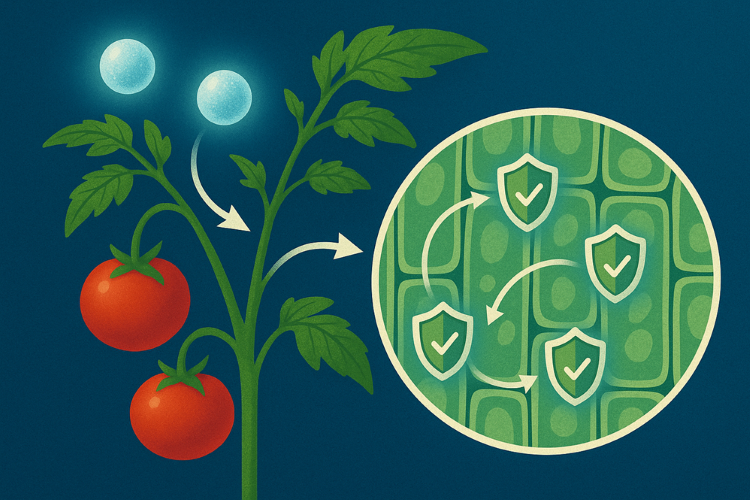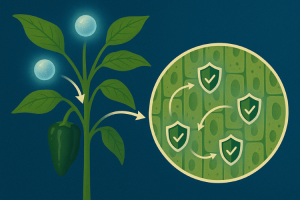Promoting sustainable agriculture with nanobiotechnology

Conceptual Image – Saladette Tomato – Nanobiotech
Team L&M
Researchers at Tecnologico de Monterrey are leading a pioneering project that explores the potential of nanobiotechnology to improve the natural processes of nutrition, immunity, and development in plants, marking an important step toward more sustainable and resilient agriculture in Mexico.
Although nanotechnology has been widely applied in sectors such as electronics and materials, its integration with biotechnology for agricultural purposes represents an emerging field with enormous potential.
The project is distinguished by inducing immunization mechanisms in plants, emulating the biological processes that vaccines generate in humans, using nanoparticles to trigger defensive responses in plants, with an initial focus on short-cycle vegetable crops in the region of Jalisco.

(Conceptual Image) Chile Poblano – Nanobiotech & Scavendish Banana – Nanobiotech (right)
“The speed of the cultivation cycles allows us to observe results in just a few months. This, combined with the use of short-cycle seeds, not only improves production but also has the potential to strengthen Mexico’s food sovereignty in a context of geopolitical changes,” says Dr. Diego Eloyr Navarro-López, Research Professor in Food Security and Nutrition within the Health Research Cluster at the School of Engineering and Science of Tecnologico de Monterrey, Guadalajara Campus, and leader of the project.
Stimulating The Production
The nanoparticles the research team has developed, such as titanium oxide or chitosan, stimulate the production of endogenous antioxidant compounds in plants, improving their growth, resistance to water stress, and their ability to absorb nutrients.
In addition, the technology promotes interaction between roots and beneficial soil microorganisms, enhancing metabolic development and water absorption under adverse conditions.
Studies conducted so far in the laboratory and greenhouse (TRL4 level) indicate high compatibility with soil microorganisms, with no detectable toxic effects on plants, fish, or animals.
However, the next step will be to take these tests to open-field crops to evaluate the real impact on agricultural ecosystems.
In a context where there is still no specific legislation for nano-agricultural-inputs in Mexico, the team seeks to stay ahead of the regulatory framework with a strategy based on the synthesis of stable and biocompatible nanoparticles, prioritizing compounds already approved in other industries (such as chitosan or hydroxyapatite).
The objective is also to have political impact, contributing scientific evidence to the development of appropriate regulation.
The relevant authorities include COFEPRIS, SENASICA, and SAGARPA, which require rigorous studies on toxicity, environmental impact, and accumulation in aquifers.
Advances Validated in Crops
The advances have been validated in crops such as poblano pepper, saladette tomato, Cavendish banana, and blueberry, with promising results.
Through partnerships with farmer cooperatives and biological fertilizer companies, the aim is to scale the technology and facilitate its adoption in the field.
“The production of microorganisms is simple and low-cost; moreover, we apply the nanoparticles in microdoses, which makes them viable for medium-scale producers,” explains Dr. Navarro-López.
On the other hand, Dr. Edgar René López Mena, research professor with a Ph.D. in solid-state physics and co-leader of the research initiative, noted that the production of a single gram of nanoparticle—although it may take days or weeks depending on its type—is carried out under strict control to ensure its effectiveness and safety.
The Future Landscape: Circular Economy and Regenerative Agriculture
The team is already working on foliar formulations and on the revalorization of citrus waste and essential oils as raw materials for new nanoparticles, thus promoting the circular economy.
The synergy between science and sustainability drives a regenerative agricultural model that seeks to reduce the use of chemical fertilizers and environmental impact, without compromising productivity.
The project is supported by a multidisciplinary team composed of agricultural biotechnologists, physicists, computer engineers, and specialists in computational modeling and machine learning.
International collaborations with the University of British Columbia (Canada) and the University of La Frontera (Chile) strengthen the scientific component, from plant molecular dynamics to the design of nanoparticles combined with microorganisms.
Safety Studies
Dr. Navarro-López also noted that safety studies will soon begin in collaboration with the University of the Andes in Colombia, while partnerships with national institutions such as UNAM and the University of Guadalajara remain active.
Nanobiotechnology represents a powerful tool for transforming Mexican agriculture. However, its large-scale adoption will depend on favorable public policies, appropriate regulatory frameworks, and training programs for farmers.
“Change is not only technological but also cultural. Our goal is for this technology to reach those who need it most—accessibly, safely, and with results that translate into social and environmental well-being,” concluded Dr. Navarro-López.


